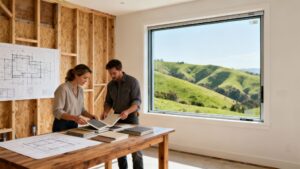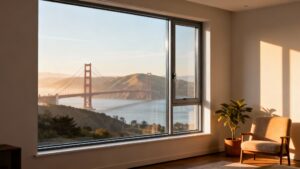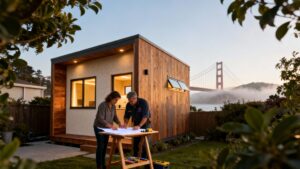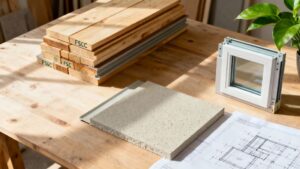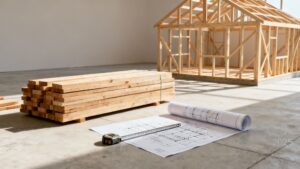For builders, contractors, and remodelers in the East Bay, a project's success starts long before you drive the first nail. It begins with finding the right supplier. Truitt & White is the trusted source for quality lumber in the East Bay, and for good reason. We stock one of the widest selections of construction-grade lumber in Northern California.
This guide will help you find premium lumber for your projects. We’ll show you how to source materials that ensure structural strength and meet the unique needs of Bay Area building.
Finding the Best Lumber in the East Bay

Finding the right lumber in Berkeley, Oakland, or anywhere in the Bay Area is about more than just wood. It’s about making sure your project lasts. Your material choices affect everything from safety to the final look.
This guide will show you how to spot top-quality lumber. We’ll also explain why a local, experienced supplier makes all the difference. We are here to make selecting and sourcing materials easier for you.
What Makes a Lumber Supplier Stand Out in the Bay Area
Not all lumberyards are the same. A great supplier provides reliable materials and expert advice that professionals can count on. For any project in the East Bay, these are the key features to look for:
- Vast Selection: You need access to a wide range of construction-grade lumber. A large inventory means you can find the perfect material without compromising. We partner with top mills to ensure our selection is second to none.
- Consistent Quality: The best suppliers have strong relationships with top-tier mills. This guarantees that the wood you receive is high-grade and reliable every time.
- Expert Guidance: Get advice from people who have seen it all. Our team offers material recommendations based on decades of experience with both residential and commercial projects in the Bay Area.
- Efficient Logistics: In construction, time is money. We offer on-site pickup or local delivery, saving builders time and effort. This keeps your projects on schedule and on budget.
Choosing the right lumber is like casting the right actor for a role. The wrong choice can compromise the entire production, but the right one ensures a standout performance that lasts for years.
You need to feel confident in every board you use. Whether you're building a new home in Berkeley or restoring a classic in Oakland, your materials are your legacy. To see our huge inventory, visit a premier San Francisco Bay Area lumber yard.
Why the East Bay Is a Hub for Quality Lumber
The East Bay’s reputation for great lumber isn’t new. It’s a story rooted in California’s history. The region’s ports and rail lines made it a center for the building materials trade during the state’s biggest growth periods.
This history created deep expertise and a lasting demand for durable, high-grade wood. It all started during one of the most exciting times in American history. The California Gold Rush created a huge demand for building materials as new cities were built.
The Gold Rush and a Legacy of Quality
Between 1849 and 1855, San Francisco's population grew from 2,000 to over 59,000 people. This growth required massive amounts of lumber. The East Bay became the main hub for distributing that wood.
This tradition of supplying the best materials has been passed down. Local suppliers learned early that the Bay Area’s climate—with its coastal fog and seismic risks—demanded high-performance wood. It was about providing materials that would last.
The East Bay didn't just move lumber; it curated it. Early suppliers built their reputations on providing wood that could withstand the unique demands of building iconic cities like Oakland and San Francisco, setting a high bar for quality that persists today.
Modern Demands Meet Historical Expertise
Today, that expertise still serves the region’s best builders and architects. The demand for quality has only grown. Modern construction in places like Berkeley and Oakland requires a mix of traditional woods and advanced engineered products.
Suppliers who have been here for decades understand this best. They have long-standing relationships with top mills. This guarantees a steady supply of premium lumber that meets today’s building codes and sustainability goals.
When you work with a local expert, you get more than just wood. You tap into a wealth of knowledge that helps you choose the right material for any job. You can see this when you visit a dedicated professional builders supply store in Berkeley, CA. This history is what makes the East Bay the ultimate source for quality lumber.
Your Construction Lumber Options in the Bay Area
Choosing the right lumber for a Bay Area project doesn't have to be hard. Let's review the best options for contractors in Oakland or remodelers in Berkeley. It's all about picking the right wood for the job.
Each type of wood has a specific purpose. Using the right one from the start ensures your project is strong and up to code. This saves you from costly problems later.
Here's a look at how a dedicated local supplier compares to the average, especially for sustainable sourcing. A responsibly managed inventory means builders always have access to the right materials.
The Workhorses: Douglas-Fir and Redwood
For structural framing, Douglas-fir is the top choice in Northern California. It has an excellent strength-to-weight ratio. This makes it ideal for studs, joists, and rafters.
For outdoor projects, redwood is a local favorite. Its natural oils resist rot and insects, which is a huge benefit in our coastal climate. It's the best choice for decks, fences, and siding.
Common Lumber Types for Bay Area Projects
Here is a simple breakdown of the most common lumber used on Bay Area job sites.
| Lumber Type | Primary Use | Key Benefit |
|---|---|---|
| Douglas-Fir | Structural framing (studs, joists, beams) | Superior strength-to-weight ratio |
| Redwood | Decks, fences, siding, outdoor structures | Natural resistance to decay and insects |
| Engineered Wood | Beams, headers, I-joists, sheathing | High consistency and stability; resists warping |
This table shows where each type of wood is most effective in local construction.
Engineered Wood: A Modern Solution
Engineered wood products offer great stability and consistency. These materials are made by binding wood strands or fibers together. The result is a predictable, high-performance building material.
The main benefit is that engineered wood resists warping and shrinking. This can sometimes be a problem with solid wood.
Common engineered products include:
- Laminated Veneer Lumber (LVL): Great for headers and beams where strength is critical.
- I-Joists: A smart, lightweight choice for floors and roofs that provides long, straight spans.
- Oriented Strand Board (OSB): Used for sheathing on walls and roofs, offering great strength.
These products are often needed to meet the engineering demands of modern Bay Area buildings. To learn more, see our guide on what engineered wood is and how it's used.
Most projects use a smart mix of solid and engineered lumber. An experienced supplier can help you decide where to use each type. This balanced approach is key to a project that is built to last.
How to Spot High-Quality Lumber at the Yard

Walking into a lumberyard can feel overwhelming. But learning to inspect a board is easier than you think. A few simple checks can tell you the difference between a good board and a bad one.
This is your guide for picking the best boards for your Berkeley or Oakland project.
Check for Straightness
The first thing to check is straightness. A warped board can cause many problems. To check, hold the board up and look down its length.
Here’s what to look for:
- Crown: A small arch along the edge. A minor crown is normal, but a severe one is a problem.
- Bow: A curve along the wide face of the board. A bowed board will never sit flat.
- Twist: When the corners of a board don't line up. Twisted boards are hard to work with.
When you find consistently straight lumber, it’s a sign that your supplier works with good mills. It means the wood was dried and handled correctly.
"A straight board is the foundation of good craftsmanship. Taking thirty seconds to sight each piece at the yard can save you hours of frustration on the job site."
Inspect Knots and Grain
Next, look at the knots and grain. Knots are where branches once grew. They can affect the wood's strength.
Tight knots that are solid are usually fine. Avoid boards with loose knots or large knot holes. These create weak spots.
The grain pattern also tells a story. A straight, dense grain means the board is strong and stable.
Understand Moisture Content
Finally, consider moisture content. Wood shrinks as it dries. Starting with properly dried lumber is key to preventing warping later on.
A board that feels heavy or cool might have too much moisture. A good supplier stores wood in a controlled environment. In the Bay Area, where humidity changes, using wood with the right moisture level is even more important.
Sustainable Lumber Sourcing in the Bay Area
In the Bay Area, building responsibly is very important. For clients from Berkeley to Oakland, a project's environmental impact matters. Sourcing high-quality lumber goes with making sure it comes from a well-managed forest.
This focus on sustainability adds to your project's long-term value. It shows that your work is not just built to last, but also built with the future in mind.
What are Sustainable Forestry Certifications?
A certification stamp on lumber tells you about its journey. Certifications like the Forest Stewardship Council (FSC) are a reliable sign that the lumber was harvested responsibly.
An FSC certification guarantees:
- Environmental Responsibility: The forest is managed to protect biodiversity and waterways.
- Social Benefit: The rights of local communities and workers are respected.
- Economic Viability: The forest operations are profitable without harming the ecosystem.
By choosing certified lumber, you give your clients peace of mind. They know their project supports healthy forests.
Modern Mills and Maximizing Resources
Sustainability continues at the mill. Modern technology uses every part of the log, which reduces waste. This is a big part of the sustainability puzzle.
According to the California Department of Forestry and Fire Protection, modern sawmills are highly efficient. Byproducts like sawdust and bark are used for energy or other products. This means less waste goes to landfills.
Choosing sustainable lumber isn't just about checking a box for a green building permit. It’s a deep commitment to quality that runs from the forest floor to your finished project, ensuring every board helps build a healthier planet and a more resilient structure.
When you partner with a supplier that values these practices, you ensure your project is built with top-tier, eco-friendly materials. This is how you build a lasting legacy in the Bay Area. If you want to learn more, it's worth exploring broader sustainable procurement strategies.
Streamline Your Project with an Expert Lumber Partner
Choosing the right lumber is only half the battle. The other half is finding the right partner to supply it. For any builder in the East Bay, efficiency is key. A great supplier does more than sell wood—they save you time, money, and headaches.
Think of an expert supplier as part of your team. They understand how a project works. They offer services designed to keep things moving smoothly.
Value-Added Services That Matter
In a competitive market like the Bay Area, lost time is lost profit. The best suppliers know this. They build their services around your needs.
Here are key services that make a difference:
- Reliable Local Delivery: Getting materials to your Oakland or Berkeley job site on time is crucial. A dependable delivery service prevents costly delays.
- Efficient On-Site Pickup: When you need to get materials yourself, an organized yard helps. Quick pickup gets you back to the job site fast.
These services are the backbone of a successful project. They ensure you have the right materials at the right time.
The Power of Expert Consultation
Beyond logistics, a supplier's knowledge is their most valuable asset. With decades of experience, a seasoned team can offer recommendations that prevent costly mistakes. This is what makes a supplier the ultimate source for quality lumber in the East Bay.
An expert consultation is like a pre-flight check for your project. It helps you anticipate challenges, optimize your material list for performance and budget, and confirm you're using the right wood for the Bay Area's specific codes and climate.
Imagine framing a tricky roof or choosing siding for a coastal home. An expert can point you to the right grade of Douglas-fir or a type of redwood that will stand up to our local fog. This guidance comes from years of experience in our region.
This partnership is a real professional advantage. When you're ready to build with confidence, let's connect and discuss your project's needs.
Frequently Asked Questions About Lumber
We get a lot of questions about sourcing lumber in the East Bay. Here are some of the most common ones from builders, contractors, and homeowners.
What is the best lumber for a deck in the Bay Area?
For the Bay Area climate, redwood is an excellent choice. Its natural oils make it resistant to rot and insects. This helps it hold up well in our foggy and sunny weather. Composite decking is another great low-maintenance option.
Do I need pressure-treated lumber?
Yes, if the wood will touch the ground or be in a damp spot, pressure-treated lumber is essential. Use it for deck posts, retaining walls, or fence posts. The treatment protects the wood from rot and insects for years.
What is the difference between construction-grade and finish-grade lumber?
It comes down to function and appearance. Construction-grade lumber, like Douglas-fir, is used for framing and structural work where it won't be seen. Finish-grade lumber, like clear redwood, is chosen for its appearance and is used for trim, siding, and cabinets.
How do I know my lumber is sustainably sourced?
Look for a certification stamp, like the Forest Stewardship Council (FSC) label. This shows the lumber came from a responsibly managed forest. The best way is to work with a supplier who partners with sustainable mills and can tell you about their sourcing policies.
Can you deliver lumber to my job site in Oakland?
Yes. We offer reliable local delivery across the East Bay, including Oakland and Berkeley. Getting your materials delivered saves you time and keeps your project on schedule. Our team makes sure everything arrives safely and on time.
For expert advice and access to one of Northern California’s widest selections of construction-grade materials, trust Truitt & White as your partner. Visit our Berkeley showroom or connect with us online to discuss your project needs today.





